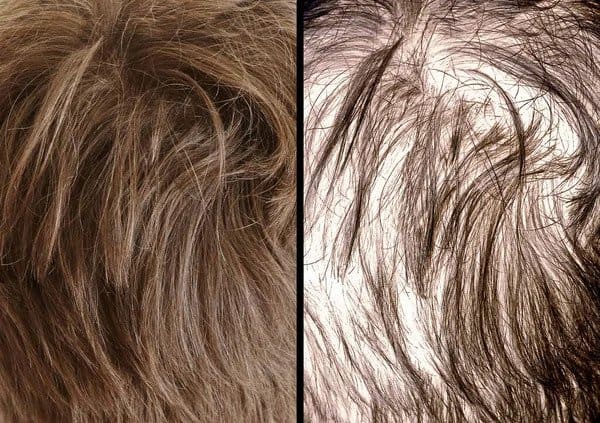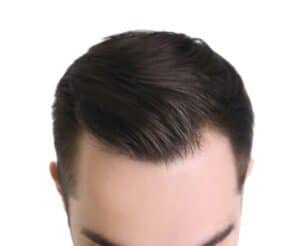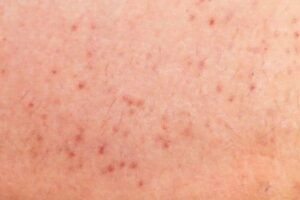Donor Area Balding: Is My Scalp Affected By Retrograde Alopecia?
Are you worried about retrograde alopecia? If you’re suffering with extensive hair loss, then a condition like retrograde alopecia may affect your chances of getting a hair transplant surgery in the future. In this article, you will find everything you need to know about retrograde alopecia, other forms of alopecia, and if you’re still going to be eligible for a hair transplant.
What is Retrograde Alopecia?
Retrograde alopecia is a hair loss condition that affects the back of the scalp. This continued miniaturisation of the hair follicles affects a man’s donor area, making it difficult for a hair transplant surgery to take place.

retrograde alopecia often occurs in a vertical fashion (also giving it the name “vertical alopecia”). This usually begins at the nape of the neck and works its way upwards into the donor area of a sufferer. Hair follicles in retrograde alopecia patients are usually of a finer than those in typical patients.
This condition usually affects men over the age of 50 years old. In most cases, retrograde alopecia patients have also suffered with extensive androgenic alopecia (male pattern baldness), and would be a stage 6 or 7 on the Hamilton Norwood Scale.
How is Retrograde Alopecia Different To Androgenetic Alopecia?
One of the main differences between retrograde and androgenic alopecia are the regions affected on the head. With male pattern baldness (androgenic alopecia), we typically think of a hair loss that occurs in a patterned way, first causing a receding hairline, and then hair loss on the crown. On the other hand, retrograde alopecia is not a patterned form of hair loss and usually affects the donor area.
Another key difference between these two forms of hair loss is the availability of surgical intervention. For patients with male pattern hair loss and a traditional donor area, this can be treated with a hair transplant surgery. For retrograde patients, surgical intervention is often dismissed as an option. However plasma therapies and finasteride can always be considered in an attempt to stabilise hair loss.
Why Can’t I Have a Hair Transplant If I Have Retrograde Alopecia?
Surgical hair restoration relies on a strong and healthy donor area across the back and sides of the head. This is because the hair follicles on the back and sides are most resistant to thinning and balding, making them ideal for the transplantation process.
The Hair Transplant Would Be Visually Obvious
When performing a hair transplant, one of the main aims of surgery is for it to be completely inconspicuous from the back of the head. In other words, a good surgery should be discrete and leave no trace that a patient has undergone surgical hair restoration.
However, in patients with retrograde alopecia, the donor area across the lateral temporal region and lower occipital zone is already (at least) partially affected by hair loss. If donor hair was to be extracted from this donor area, then it would be extremely obvious a patient has had a surgery.
The skin on the donor area would be extremely visible, causing (what is categorised by hair transplant surgeons as) “donor area over-extraction”.
The Hair Follicles Would Likely Shed
If you’re looking for a hair restoration procedure on the frontal hairline or crown (vertex) area, then good donor hair is crucial. The reason many patients have come for surgery in the first place, is because they have suffered with hair loss to start with.
For patients with androgenic alopecia, using hair follicles that are, themselves, prone to hair hair loss would make a hair transplant pointless. Density reduction would likely occur in the transplanted (recipient) area, wasting the patients time and money!
There is little point in implanting high risk donor hairs into a recipient area, as eventual follicular death is extremely likely.
Can I Go Abroad For a Hair Transplant If I Have Retrograde Alopecia?
For any patient suffering with retrograde alopecia, our suggestion would always be to avoid surgical reconstruction of any kind. In the UK, there is always a strong reason why a patient may be denied a hair transplant procedure that is based upon surgical expertise and sound logic.
Whilst there may be other clinics across the world that may take on a patient affected by retrograde alopecia, a question definitely needs to be asked about why they are taking on a high risk patient:
- does the surgeon have enough expertise to spot retrograde alopecia?
- is a clinic trying to make a “quick buck”, so to speak, out of a patient?
Performing hair transplantation with a sub-optimal donor area is always high risk and will, in almost all cases, result in a poor result. Not to mention, a second surgical reconstruction to fix a poor result can not take place!
What Would We Suggest As a Treatment For Patients With Retrograde Alopecia?
As hair transplantation is not usually an option for patients with retrograde alopecia, there are some other forms of hair loss treatment that can be recommended.

Minoxidil and Plasma therapies (PRP) are always an option for retrograde patients. These two treatments work in a similar way by increasing the amount of blood flow around the hair follicles on the nape of the neck. The theory being that with an increase in the amount of blood flow, hair loss will be stabilised and the hair follicles will look thicker and fuller.
Finasteride and Dutasteride are also treatments often recommended for retrograde alopecia patients. These medications are DHT blockers, preventing the hormone DHT from binding to your hair follicles, and preventing retrograde. hair loss
Some sufferers do opt for low level laser therapy (LLLT). Results for this treatment do look promising. However, “success stories” for retrograde alopecia patients who have tried low level laser therapy are largely based on small trials and anecdotal evidence. So, it may be better to opt for a treatment with a little more of a proven track record.
Conclusion: What’s the Verdict?
Having a diagnosis of retrograde alopecia is certainly upsetting for any patient or sufferer. Having retrograde alopecia would almost certainly rule out any patient from having the hair transplantation process, consigning them to baldness.
However, there are some alternatives to consider if you want a full head of hair and suffer with retrograde alopecia, like toupés and wigs.
If you’re worried about the fact you may be suffering with retrograde alopecia, then book your free consultation today. We’re always happy to meet new patients and give you a diagnosis on any condition you may be suffering with.








